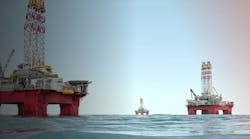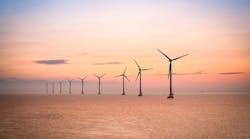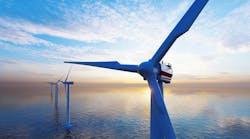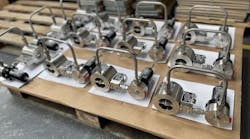The use of gaseous nitrogen use in oil and gas production applications is steadily increasing. While conventionally used in blanketing and inert offshore applications, on-site gaseous nitrogen - supplied at high flow rates and pressures - is finding increased use in drilling, injection for reservoir and wellbore pressure maintenance, and in coiled tubing operations. Such operations include the following:
- Downhole: In many drilling and completion operations, nitrogen has helped eliminate the danger of downhole fires and explosions that can occur when air reacts with hydrocarbons in the wellbore or pay zone areas. With nitrogen, an extremely light drilling fluid can be used, minimizing loading of the drill bit, and producing higher rates of penetration.
- Pressure maintenance: Nitrogen maintains the reservoir pressure of formations that have suffered diminished productivity over time from natural pressure depletion. Gas condensate formations must be pressurized above the dew point of the hydrocarbons present or condensation will take place, making further production of condensates impractical. The oil production of wells with limited gas reserves can be enhanced with reservoir pressure supplied by nitrogen injection. Higher flows of nitrogen are needed for a short time during these operations, depending on the amount of material moved and the distance.
- Coil tubing: Nitrogen generators, equipped with high-pressure booster compressors, are increasingly being used to deliver gaseous nitrogen in a growing number of coil tubing operations. Coiled tubing units have replaced conventional rotary units and readily perform well displacements, cleanouts, jetting operations, gas lift procedures, and numerous other workover techniques. Coil tubing also transports acids and reactive chemicals down the wellbore and tubing corrosion is a concern. Low density, high-pressure gaseous nitrogen is ideal for these applications.
- Well completion/workovers: The low density, high pressure properties of nitrogen make it ideal for use in a variety of well completion applications such as cementing operations (including control of cement slurry weights), pressure-activated devices, well cleaning, and fluid displacements. High-pressure nitrogen can displace drilling fluids, reduce hydrostatic heads, and allow the well to resume production. The use of nitrogen in cleanout operations does little or no damage to the formation and may enhance well production and longevity.
- Under-balanced drilling: On-site gaseous nitrogen is used alone or in combination with drilling fluid to lighten and control hydrostatic and downhole pressures in under-balanced drilling applications. A light drilling fluid reduces the weight of the column of fluid in the borehole. The drilling fluid and formation products flow back to the surface in a controlled, closed circulation system. Optimal operating conditions can generate 1,500-3,000 scfm of nitrogen.
- Purging: Purging is necessary to clear lines and vessels of liquids or reduce oxygen levels. Several purge cycles may be required, depending on the purity of nitrogen and the desire oxygen content. Flow and volume requirements are generally quite large. To successfully purge a vessel or pipeline, 4-8 volume turnovers of 95-98% purity nitrogen are typically required.
- Gas lift: The production of wells experiencing pressure depletion can be enhanced if the hydrostatic head can be lightened by introducing nitrogen as a gas lift mechanism in the annulus of the well or in parasitic strings. Hydrostatic pressure is reduced, promoting greater oil and gas production rates.
Nitrogen production
With purities of 95-99% acceptable for most offshore operations, gaseous nitrogen generation at high pressures and low oxygen levels safely prevents ignition of flammable gases and corrosion of oil field tubulars downhole. A colorless, odorless, and tasteless gas, nitrogen constitutes 78.03% of air. It has a gaseous specific gravity of 0.967 and a boiling point of -198° C at atmospheric pressure. The inert properties of nitrogen make it suitable for offshore applications due to its non-reactive nature with many materials. Commercial nitrogen is produced by a variety of air separation processes, including cryogenic liquefaction and distillation, pressure swing adsorption (PSA), and membrane separation. Membrane separation, which takes place on-site, filters out oxygen from a stream of compressed dry air via hundreds and thousands of hollow polymeric fibers - each of which is thinner than a human hair - to produce gaseous nitrogen (Generon patented method).
This air separation is based on the principle of selective permeation, whereby each gas constituent has a characteristic permeation rate that is a function of its ability to dissolve and diffuse through a membrane. These variable permeation rates allow "fast" gases, such as oxygen and water vapor to be separated from "slow" gases such as nitrogen.




